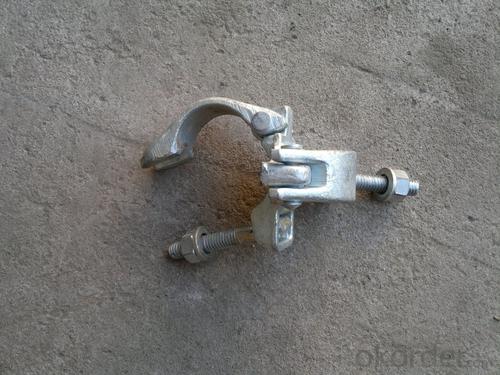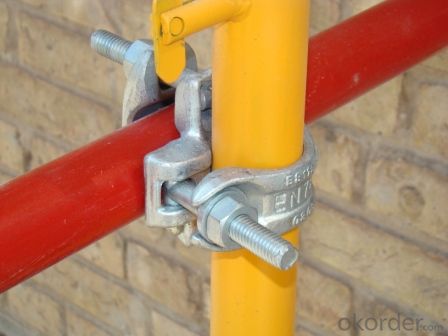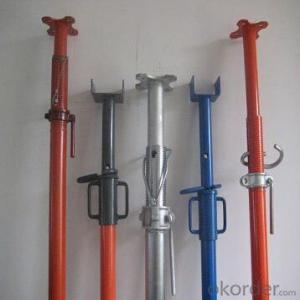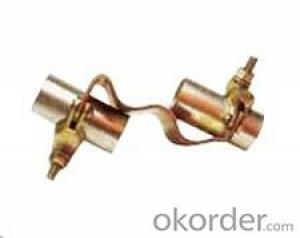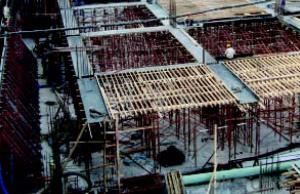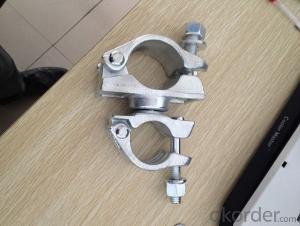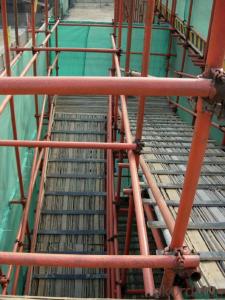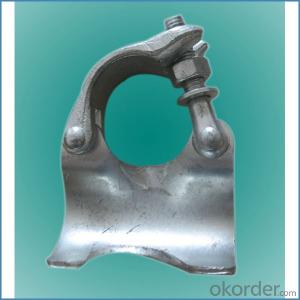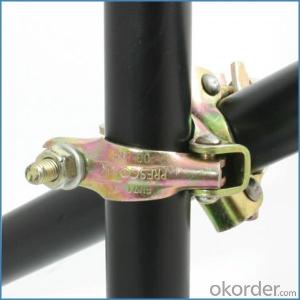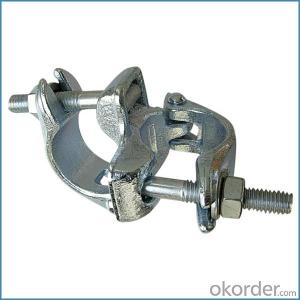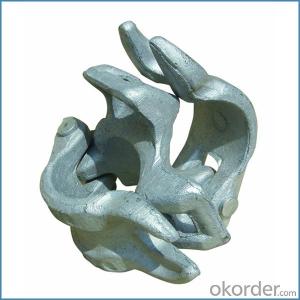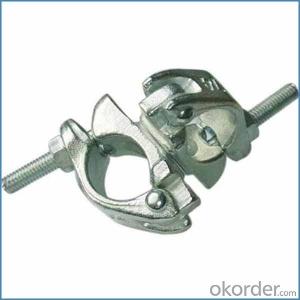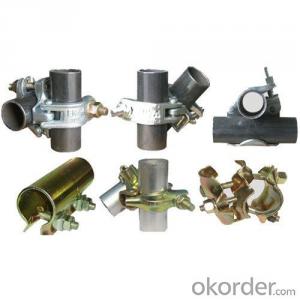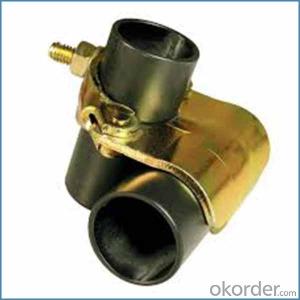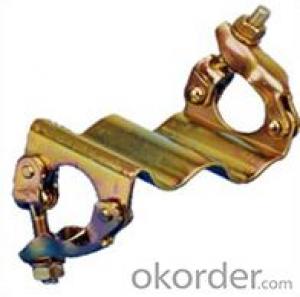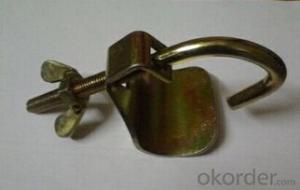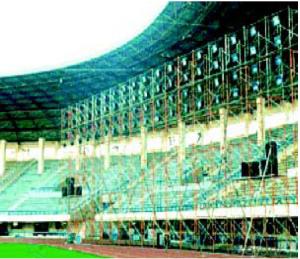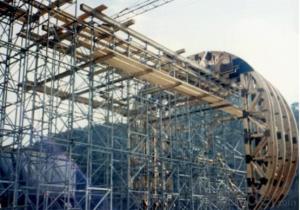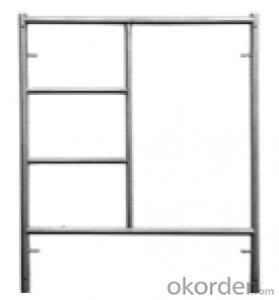Bs1139 Scaffolding Clamp british German Forged Type
- Loading Port:
- Tianjin
- Payment Terms:
- TT OR LC
- Min Order Qty:
- 1000 kg
- Supply Capability:
- 100000 kg/month
OKorder Service Pledge
OKorder Financial Service
You Might Also Like
Bs1139 Scaffolding Clamp british German Forged Type
Description
1.The scaffolding coupler is always used to connect the steel pipe as scaffolding system.
2.The often used coupler is swivel coupler and righ angle coupler .
3.We can provide types of scaffolding coupler according to your requirement.
4.Couoler can fix the 48.3mm scaffolding steel pipe tightly and make the whole scaffolding system more steadily.
Feature
(1)Excellent Anti-Breaking—Cold Pressed Steel
(2)Outstanding Resistance Deformation
(3)Strong Anti-Dropping Ability
Photo
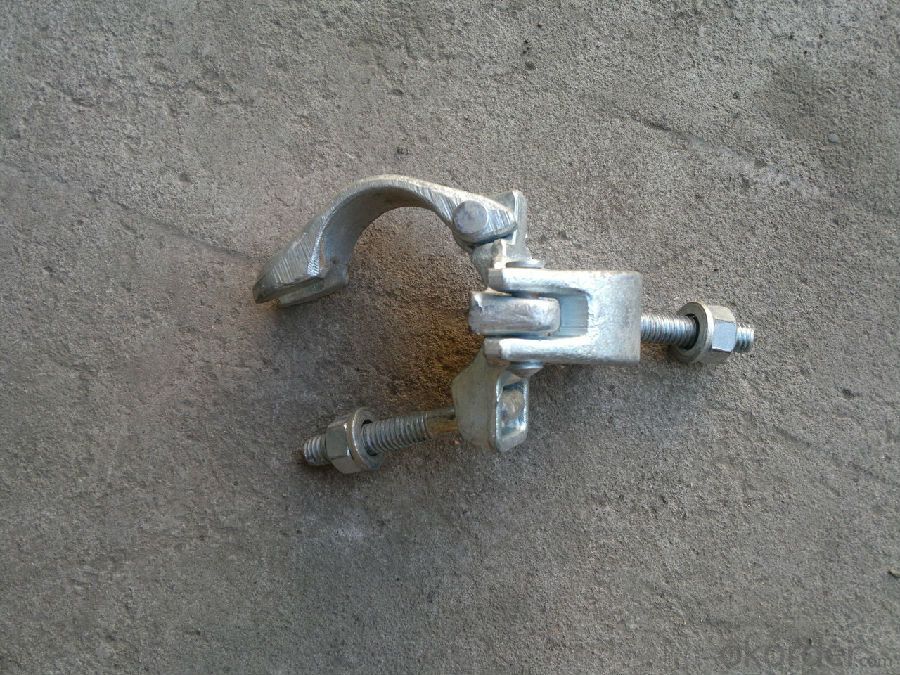
Parameter
| Material | Q235,345steel |
| Size | 48.3mm*48.3mm |
| Surface finish | Galvanized |
| Weight | 1.1kg around |
| Standard | BS1139,EN74 |
| Package | 25pcs/bag,steel pallet |
| Manufacture | As per customer requirement |
| Market | Africa, South America, the Middle East and Asia |
FAQ
Q: Are you a factory or trading company?
We are a state-owned corporation in China,dealing with various kinds of building materials.We have our holding subsidiaries.
Q: Where is your factory located? How can I visit there?
Our factory is located all around China.
Q: Can I get some samples?
Sample is free, customer only pay freight for the first time.
Q: Delivery?
10-30days. (5-15 containers)
Any question,feel free to contact us.
- Q: What are the recommended torque specifications for tightening steel tube couplers?
- The torque specifications for tightening steel tube couplers may vary depending on the specific type and size of the coupler. It is crucial to consult the manufacturer's guidelines and specifications for the exact coupler being utilized. Typically, torque specifications for steel tube couplers range from 15 to 30 foot-pounds (20 to 40 Newton-meters). To ensure precise and consistent torque application, it is essential to utilize a torque wrench. Excessive tightening can cause damage or failure of the coupler, while insufficient tightening can lead to leaks or inadequate joint strength. Always adhere to the manufacturer's recommendations and guidelines to guarantee proper installation and performance of steel tube couplers.
- Q: Can steel tube couplers be used in scaffolding structures with multiple levels or tiers?
- Yes, steel tube couplers can be used in scaffolding structures with multiple levels or tiers. Steel tube couplers are commonly used in scaffolding systems to connect and secure steel tubes or pipes, allowing for the creation of stable and versatile scaffolding structures. These couplers can be used to construct scaffolding with multiple levels or tiers, providing a safe and reliable support system for workers and equipment.
- Q: How do steel tube couplers work in scaffolding?
- Steel tube couplers are a crucial component in the construction of scaffolding systems as they provide a secure and reliable connection between steel tubes. These couplers are designed to join two tubes together, allowing them to be aligned and fixed in place to create a stable and robust scaffold structure. The working mechanism of steel tube couplers is quite straightforward. They consist of two main parts: a nut and a bolt. The nut is threaded and has two flat ends, while the bolt is also threaded and has a tapered end. When assembling the scaffolding, two tubes are positioned adjacent to each other, with their ends overlapping. The coupler is then placed over the two tubes, and the bolt is inserted through the holes in both tubes, while the nut is screwed onto the bolt. As the nut is tightened onto the bolt, it pulls the two tubes together, creating a tight and secure connection. The tapered end of the bolt helps to facilitate this process by gripping the inner walls of the tubes, preventing any movement or slippage. The threaded design of the nut and bolt also ensures that the connection remains firm and stable, even under heavy loads or vibrations. Moreover, steel tube couplers are designed to be versatile, allowing for various configurations and angles in scaffolding construction. They come in different types, such as swivel couplers, sleeve couplers, and putlog couplers, each serving a specific purpose in joining tubes together at different angles and orientations. In summary, steel tube couplers play a vital role in scaffolding by providing a secure and reliable connection between steel tubes. Their simple yet effective design ensures a strong and stable scaffold structure, allowing workers to safely access and work at elevated heights.
- Q: How do steel tube couplers compare to other types of scaffolding connectors in terms of cost?
- Steel tube couplers are generally more cost-effective compared to other types of scaffolding connectors. This is mainly due to their lower manufacturing costs and the abundance of steel as a construction material. Additionally, steel tube couplers are reusable, which further reduces long-term expenses.
- Q: How do steel tube couplers prevent scaffolding tubes from bending or deforming under load?
- Steel tube couplers are essential in maintaining the integrity of scaffolding tubes under load. These couplers, made from high-quality steel, are renowned for their strength and durability. This allows them to withstand heavy loads without any bending or deformation. The design of the couplers also plays a crucial role in preventing bending or deformation. Typically, scaffolding systems utilize couplers with a clamping mechanism, such as bolts or wedges, which securely fasten the tubes together. This mechanism creates a robust connection that evenly distributes the load, eliminating any potential movement or slippage. Moreover, the couplers are engineered to fit tightly around the tubes, ensuring a snug fit. This tight fit eradicates any gaps or spaces between the tubes, guaranteeing they remain straight and aligned even under load. It also prevents any lateral movement or rotation that could lead to bending or deformation. To further enhance stability and load-bearing capacity, multiple couplers are used along the length of the scaffolding tubes. This evenly distributes the load across multiple connection points, greatly reducing the risk of bending or deformation. In conclusion, steel tube couplers are instrumental in maintaining the structural integrity of scaffolding systems. Through their high-quality steel construction, clamping mechanisms, tight fit, and distribution of load, they effectively prevent bending or deformation.
- Q: What are the typical installation methods for steel tube couplers in scaffolding?
- There are several typical installation methods for steel tube couplers in scaffolding. One common method is the sleeve coupler installation. This involves sliding the sleeve coupler onto the end of a scaffold tube, ensuring it is positioned correctly and aligning the holes on both the coupler and the tube. Once aligned, a steel bolt is inserted through the holes and tightened using a wrench, creating a secure connection between the tube and the coupler. Another method is the swivel coupler installation. Swivel couplers are used to connect two scaffold tubes at any angle, making them highly versatile. To install a swivel coupler, the coupler is placed between the two tubes, ensuring that the holes on all three components align. A steel bolt is then inserted through the aligned holes and tightened using a wrench, creating a strong connection that allows for rotation and adjustment. Additionally, there is the putlog coupler installation method. Putlog couplers are used to connect scaffold tubes to walls or other structures. To install a putlog coupler, the coupler is positioned against the structure, and the putlog tube is inserted into the coupler. A steel bolt is then inserted through the holes on the coupler and tightened, securing the putlog tube in place. Lastly, the girder coupler installation method is used to connect scaffold tubes to steel beams or girders. This involves placing the girder coupler onto the beam or girder, ensuring the holes on both components align. A steel bolt is then inserted through the aligned holes and tightened, creating a secure connection. Overall, these installation methods for steel tube couplers in scaffolding provide reliable and sturdy connections, allowing for safe and efficient construction activities.
- Q: Do steel tube couplers require any additional safety measures during installation?
- Yes, steel tube couplers may require additional safety measures during installation to ensure proper installation and prevent any potential hazards. Some of the additional safety measures that might be needed include: 1. Personal Protective Equipment (PPE): Installers should wear appropriate PPE such as gloves, safety glasses, and steel-toe boots to protect themselves from any potential injuries or accidents. 2. Training and Certification: Installers should be adequately trained and certified in the proper installation techniques and safety procedures for steel tube couplers. This can help prevent any errors or mistakes during installation that could compromise safety. 3. Inspection and Testing: Before installation, it is important to inspect the steel tube couplers for any defects or damage that may affect their performance or safety. Additionally, testing the couplers to ensure they meet the required strength and performance standards is essential. 4. Proper Handling and Storage: Steel tube couplers should be handled and stored in a way that prevents damage or deformation. Dropping or mishandling couplers can compromise their structural integrity and safety. 5. Secure Installation: Couplers should be properly aligned and securely fastened to ensure they can withstand the intended loads and forces. It is crucial to follow the manufacturer's guidelines and specifications for installation to ensure proper performance and safety. 6. Supervision and Quality Control: Having a supervisor or quality control personnel oversee the installation process can help ensure that all safety measures are followed correctly and that the installation is done properly. By implementing these additional safety measures, the risk of accidents, injuries, or structural failures during the installation of steel tube couplers can be minimized, ensuring a safe and reliable installation.
- Q: Can steel tube couplers be used in confined spaces?
- Confined spaces can indeed accommodate steel tube couplers. These couplers, commonly employed in construction, serve the purpose of connecting and joining steel tubes together. Versatile and adaptable, they prove useful in various scenarios, including cramped construction sites, underground pipelines, and tunnels. Compact and lightweight, steel tube couplers excel in confined spaces with limited room. Their easy maneuverability and installation facilitate efficient construction within tight areas. Furthermore, their ability to bear heavy loads ensures the structural integrity and stability of connected tubes in such restricted environments. Adding to their appeal, steel tube couplers resist corrosion and boast remarkable durability, making them viable for long-term usage in challenging conditions. Their strength and dependability establish them as a reliable choice for confined spaces where safety and performance are paramount. In conclusion, steel tube couplers offer a suitable solution for confined spaces, thanks to their compact design, easy installation, high load-bearing capacity, and durability. However, it remains crucial to consider the specific requirements and regulations of the particular confined space and ensure compliance with safety standards before employing steel tube couplers.
- Q: Are steel tube couplers compatible with different pipe sizes?
- Different pipe sizes are not compatible with steel tube couplers. Steel tube couplers are designed exclusively for connecting tubes or pipes that have the same size and dimensions. By doing so, they create a robust and reliable connection between the two tubes, guaranteeing structural stability and integrity. If one attempts to use a steel tube coupler with pipes of varying sizes, an improper fit will occur, which may lead to leaks, weak connections, or even structural failure. Therefore, it is crucial to utilize the appropriate size of steel tube coupler that corresponds to the size and dimensions of the pipes being connected.
- Q: What does this mean exactly?Thanks :)
- Ribosomal RNA has a structural role (among other functions), acting as a scaffold to support the positions of the ribosomal proteins.
Send your message to us
Bs1139 Scaffolding Clamp british German Forged Type
- Loading Port:
- Tianjin
- Payment Terms:
- TT OR LC
- Min Order Qty:
- 1000 kg
- Supply Capability:
- 100000 kg/month
OKorder Service Pledge
OKorder Financial Service
Similar products
Hot products
Hot Searches
Related keywords


